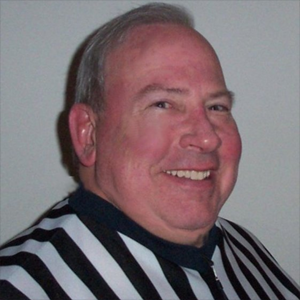
Rndballref
20 Years Experience
Chicago, IL
Male, 60
For twenty years I officiated high school, AAU and park district basketball games, retiring recently. For a few officiating is the focus of their occupation, while for most working as an umpire or basketball referee is an avocation. I started ref'ing to earn beer money during college, but it became a great way to stay connected to the best sports game in the universe. As a spinoff, I wrote a sports-thriller novel loosely based on my referee experiences titled, Advantage Disadvantage
I think the pre-game conference rules are dictated by each state.
On a spot throw-in, a player must stay within a 3 foot area along the out of bounds boundary. That three foot area extends from the out of bounds line all the way back to the wall, or the first obstruction (bleachers, table, etc.).
So to answer your question, as long as the player does not step in bounds before releasing the ball, he can take as many steps forward short of breaching the out bounds line.
If your partner said that he whistled the ball dead inadvertently, it does not matter if no one in the gym heard it - the ball was dead when he blew his whistle. He should have taken the points off the board, apologized to the coach and put the ball in play at the point of the inadvertent whistle.
If the ball is live, then any foul can be called. If the ball is dead, the only foul which can be called is a technical.
On a throw in, the ball is live (even though the clock is not running) when it is at the disposal of throw in player ... in other words when the referee hands or bounces the ball to the player. So, yes a common foul can be called before the clock runs.
Court Reporter
 If your special keyboard lets you type 200+ words per minute, why doesn't everyone use them?
If your special keyboard lets you type 200+ words per minute, why doesn't everyone use them?
Chick-fil-A General Manager
 What's the back-story behind the cow mascot and eat-mor-chikin campaign?
What's the back-story behind the cow mascot and eat-mor-chikin campaign?
Certified Nurse Aide
 Is it true that STD rates in nursing homes are going through the roof?
Is it true that STD rates in nursing homes are going through the roof?
I obviously didn't see the play, but if the defender has obtained legal guarding position (that is, he is entitled to the space he is at) and the opponent crashes his face into the defender's knee it is either a no-call or an offensive player control foul.
The ref should stop the game right away if a player is injured or in imminent danger. The ref can delay the play stoppage to allow the offensive team to complete a play if there is no immediate danger to any players. The refs are also to stop play immediately if there is a vision issue such as lost contact lense or glasses knocked off someone's head.
In your situation, I would have let the offense finish the play - BUT if the offense was driving to the basket and then kicked the ball back out out to reset the play, I would have stopped the game,
One principle is that you cannot travel between dribbles. Iverson probably travels (high school rules) when he jumps forward BEFORE he dribbles, a move Michael Jordan used as well. Iverson also, like Jordan, carries the ball (a NFHS violation) in the video several times but this seems to be allowed by the NBA.
-OR-
 Login with Facebook
Login with Facebook (max 20 characters - letters, numbers, and underscores only. Note that your username is private, and you have the option to choose an alias when asking questions or hosting a Q&A.)
(A valid e-mail address is required. Your e-mail will not be shared with anyone.)
(min 5 characters)
By checking this box, you acknowledge that you have read and agree to Jobstr.com’s Terms and Privacy Policy.
-OR-
 Register with Facebook
Register with Facebook(Don't worry: you'll be able to choose an alias when asking questions or hosting a Q&A.)